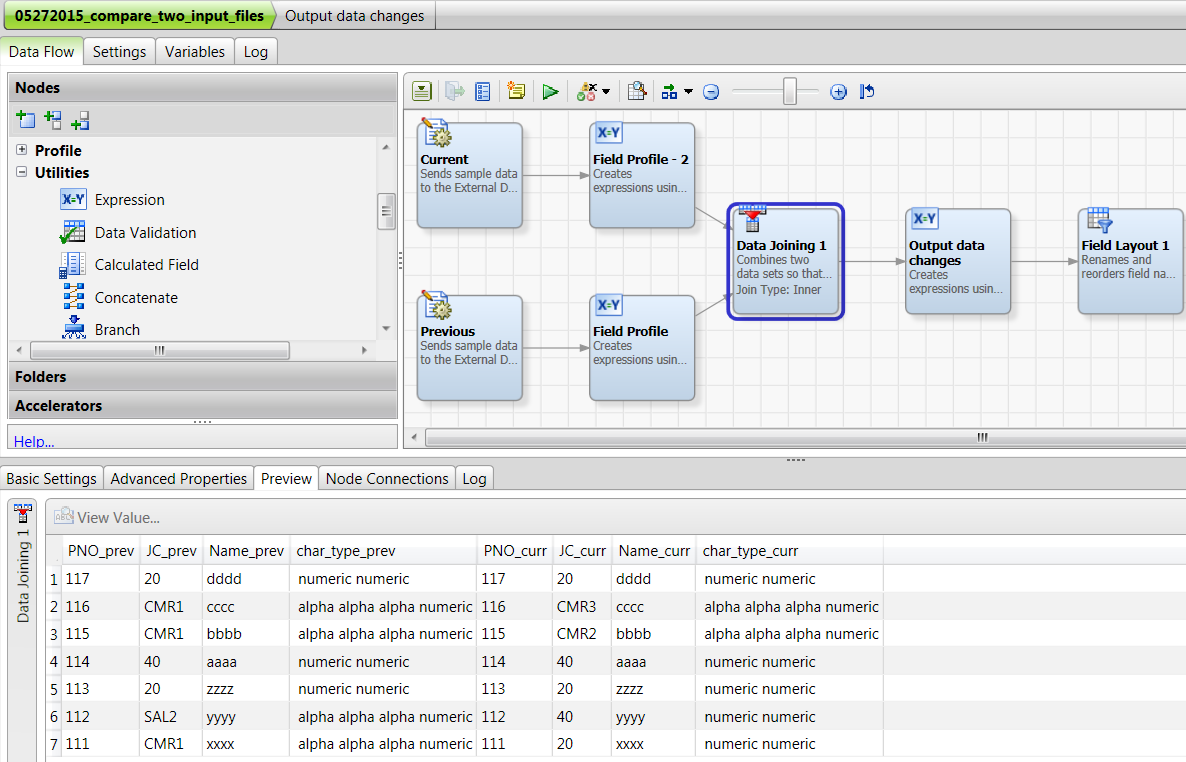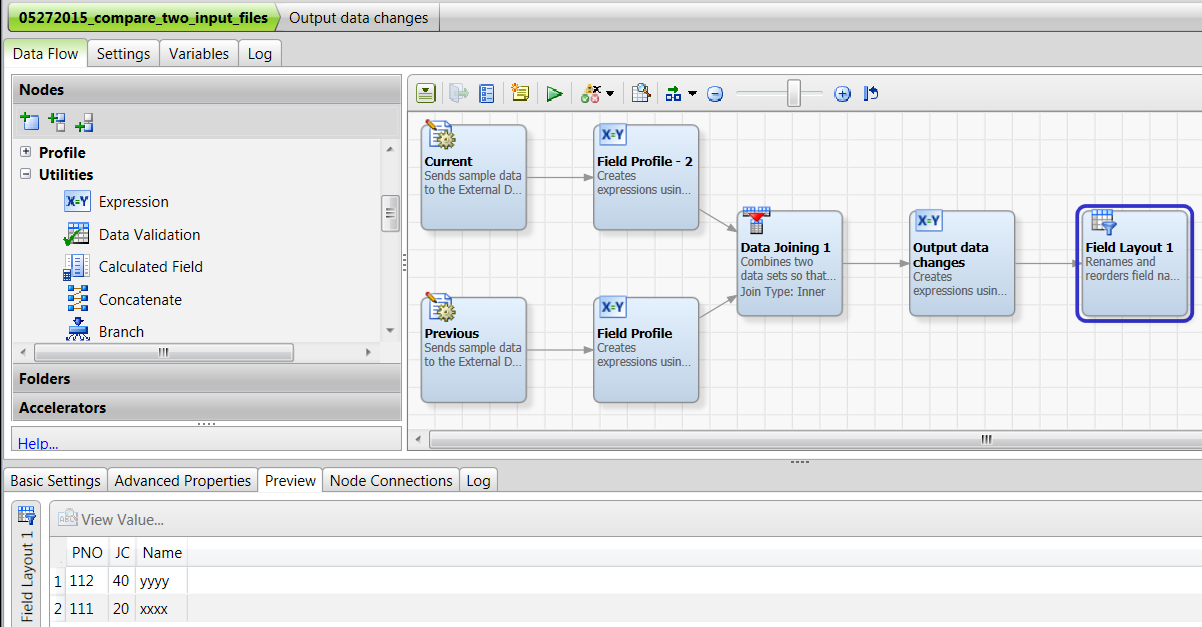- Home
- /
- Solutions
- /
- Data Management
- /
- To compare two input files in Data Management Studio 2.4
- RSS Feed
- Mark Topic as New
- Mark Topic as Read
- Float this Topic for Current User
- Bookmark
- Subscribe
- Mute
- Printer Friendly Page
- Mark as New
- Bookmark
- Subscribe
- Mute
- RSS Feed
- Permalink
- Report Inappropriate Content
I have two input files in data job to compare the data. The requirement is, if the JC (field) is changed from previous file to current file (if the JC changes from alphanumeric character to numeric character) then it should display the output.
For e.g.
File 1 File 2
| Previous Table | Current Table | |||||
| PNO | JC | Name | PNO | JC | Name | |
| 111 | CMR1 | xxxx | 111 | 20 | xxxx | |
| 112 | SAL2 | yyyy | 112 | 40 | yyyy | |
| 113 | 20 | zzzz | 113 | 20 | zzzz | |
| 114 | 40 | aaaa | 114 | 40 | aaaa | |
| 115 | CMR1 | bbbb | 115 | CMR2 | bbbb | |
| 116 | CMR1 | cccc | 116 | CMR3 | cccc | |
| 117 | 20 | dddd | 117 | 20 | dddd | |
| 118 | 20 | eeee | 120 | 20 | llll | |
| 119 | 20 | ffff | 121 | 20 | kkkk | |
For the above table the output should be as below becoz the data is changing from CMR1 to 20, i.e. alphanumeric to numeric.
| PNO | JC | Name |
| 111 | 20 | xxxx |
| 112 | 40 | yyyy |
Regards,
Shaheen
- Mark as New
- Bookmark
- Subscribe
- Mute
- RSS Feed
- Permalink
- Report Inappropriate Content
Hello All,
Any input or view point on the above question?
Regards,
Shaheen
- Mark as New
- Bookmark
- Subscribe
- Mute
- RSS Feed
- Permalink
- Report Inappropriate Content
Should any change be caught (ie 20 to 40), or just a change in type?
- Mark as New
- Bookmark
- Subscribe
- Mute
- RSS Feed
- Permalink
- Report Inappropriate Content
Its mainly change in type. No other changes.
- Mark as New
- Bookmark
- Subscribe
- Mute
- RSS Feed
- Permalink
- Report Inappropriate Content
This will detect changes from alpha to numeric:
data want (keep=PNO JC Name);
merge
file1 (in=in1 rename=(JC=JC_old))
file2 (in=in2 drop=Name)
;
by PNO;
if in1 and in2;
int_string = trim(JC_old); * get rid of leading blanks;
num = notdigit(int_string);
if num ne 0 and num ne length(int_string) + 1; * JC_old is alpha;
int_string = trim(JC); * get rid of leading blanks;
num = notdigit(int_string);
if num = 0 or num = length(int_string) + 1; * JC is numeric;
run;
- Mark as New
- Bookmark
- Subscribe
- Mute
- RSS Feed
- Permalink
- Report Inappropriate Content
You might want to check the documentation regarding TRIM function.
- Mark as New
- Bookmark
- Subscribe
- Mute
- RSS Feed
- Permalink
- Report Inappropriate Content
- Mark as New
- Bookmark
- Subscribe
- Mute
- RSS Feed
- Permalink
- Report Inappropriate Content
This might adequate and is pretty simple.
input (PNO JC Name)($);
cards;
111 CMR1 xxxx
112 SAL2 yyyy
113 20 zzzz
114 40 aaaa
115 CMR1 bbbb
116 CMR1 cccc
117 20 dddd
118 20 eeee
119 20 ffff
;;;;
run;
proc print;
run;
data Current;
input (PNO JC Name)($);
cards;
111 20 xxxx
112 40 yyyy
113 20 zzzz
114 40 aaaa
115 CMR2 bbbb
116 CMR3 cccc
117 20 dddd
120 20 llll
121 20 kkkk
;;;;
run;
proc print;
run;
data want;
merge
Previous(in=in1 rename=(JC=PrevJC))
Current(in=in2 rename=(name=CurName))
;
by PNO;
if in1 and in2;
n1 = input(prevjc,?? f8.);
n2 = input(jc ,?? f8.);
if missing(n1) and not missing(n2);
run;
proc print;
run;
- Mark as New
- Bookmark
- Subscribe
- Mute
- RSS Feed
- Permalink
- Report Inappropriate Content
Code: Program
data Previous;
input (PNO JC Name)($);
cards;
111 CMR1 xxxx
112 SAL2 yyyy
113 20 zzzz
114 40 aaaa
115 CMR1 bbbb
116 CMR1 cccc
117 20 dddd
118 20 eeee
119 20 ffff
;;;;
run;
data Current;
input (PNO JC Name)($);
cards;
111 20 xxxx
112 40 yyyy
113 20 zzzz
114 40 aaaa
115 CMR2 bbbb
116 CMR3 cccc
117 20 dddd
120 20 llll
121 20 kkkk
;;;;
run;
data want;
merge
Previous( rename=(JC=PrevJC))
Current(rename=(name=CurName))
;
by PNO;
if prxmatch('/^[a-z]+\d+$/i',strip(PrevJC)) and prxmatch('/^\d+$/i',strip(JC)) ;
run;
Xia Keshan
Message was edited by: xia keshan
Message was edited by: xia keshan fix a mistake.
- Mark as New
- Bookmark
- Subscribe
- Mute
- RSS Feed
- Permalink
- Report Inappropriate Content
Shah,
Here is a solution in DM Studio. This solution works regardless of the field type on the input table. It scans each character and creates a profile of the field (JC). The data is joined and then an expression identifies where the field profile is different and outputs that data. The expression is quite simple:
`char_type_prev` != `char_type_curr`


The data job is also attached.
-shawn
- Mark as New
- Bookmark
- Subscribe
- Mute
- RSS Feed
- Permalink
- Report Inappropriate Content
Hi Shawn,
Please attach the ddf file once again, I am not able to open it. You have used job specific data node as input file and i am using data source node as input file as there are other fields which has to be populated. I didnt get the usage of expression. Can you please eloborate it?
Hi Xia,
The code you have written, ist specially for the input i have specified. My input will keep changing. There is no fixed input to use it in coding and also are you using the expression here, it seems to me as complete coding and in data flux we have nodes and expressions. I am not good at technical. Please help me in understanding.
And also TRIM function is not very usefull.
Regards,
Shaheen
- Mark as New
- Bookmark
- Subscribe
- Mute
- RSS Feed
- Permalink
- Report Inappropriate Content
Shah,
I just used the job specific data node for demonstration purposes. If you replace this with your data inputs, assuming the column names are the same, the logic will work as expected.
This is the expression logic used in the 'Field Profile' node:
/* Pre-Expression */
hidden real field_length
hidden integer cnt
string char_type
cnt = 1
field_length = len(`JC`)
char_type = ''
while cnt <= field_length
begin
if isnumber(mid(`JC`, cnt, 1))
char_type = char_type & ' ' & 'numeric'
else
char_type = char_type & ' ' & 'alpha'
cnt = cnt + 1
end
cnt = 1
What this expression does is loop through the entire value to determine if you have all numeric, all alpha or a mix (alphanumeric). Because your input (the JC Column) can be characters or numeric the column type is set to a character (string) field. You must look at a profile of the field's value instead of the field type based on your requirement.
-shawn
Message was edited by: shawn skillman Unable to reattach the DDF.
- Mark as New
- Bookmark
- Subscribe
- Mute
- RSS Feed
- Permalink
- Report Inappropriate Content
Hello,
I really liked your solution, very creative.
But it would be possible to use the function pattern(* string *), which returns something similar to the created by their EEL ( char_type_curr == W_PATTERN_curr 😞
| PNO_curr | JC_curr | Name_curr | W_PATTERN_curr | char_type_curr | PNO_prev | JC_prev | Name_prev | W_TIPO_PREV | char_type_prev | W_PATTERN_prev |
| 117 | 20 | dddd | 99 | numeric numeric | 117 | 20 | dddd | integer | numeric numeric | 99 |
| 116 | CMR1 | cccc | AAA9 | alpha alpha alpha numeric | 116 | CMR3 | cccc | string | alpha alpha alpha numeric | AAA9 |
| 115 | CMR1 | bbbb | AAA9 | alpha alpha alpha numeric | 115 | CMR2 | bbbb | string | alpha alpha alpha numeric | AAA9 |
| 114 | 40 | aaaa | 99 | numeric numeric | 114 | 40 | aaaa | integer | numeric numeric | 99 |
| 113 | 20 | zzzz | 99 | numeric numeric | 113 | 20 | zzzz | integer | numeric numeric | 99 |
| 112 | SAL2 | yyyy | AAA9 | alpha alpha alpha numeric | 112 | 40 | yyyy | integer | numeric numeric | 99 |
| 111 | CMR1 | xxxx | AAA9 | alpha alpha alpha numeric | 111 | 20 | xxxx | integer | numeric numeric | 99 |
This solution could also be a ??
Thanks,
Ricardo Benatti.
- Mark as New
- Bookmark
- Subscribe
- Mute
- RSS Feed
- Permalink
- Report Inappropriate Content
The code I supplied essentially created a user-defined function vs. using an existing function. Creating a user-defined function can enable the users to see what is happening behind the scenes with the pattern() function.
Either way will work.
- Mark as New
- Bookmark
- Subscribe
- Mute
- RSS Feed
- Permalink
- Report Inappropriate Content
so ...
also understand how you ...
EEL exemplifies the treatment attribute ...
the functions implemented by the solution should have a better performance ...
the intention was to contribute only ...
Regards,
April 27 – 30 | Gaylord Texan | Grapevine, Texas
Registration is open
Walk in ready to learn. Walk out ready to deliver. This is the data and AI conference you can't afford to miss.
Register now and lock in 2025 pricing—just $495!
Need to connect to databases in SAS Viya? SAS’ David Ghan shows you two methods – via SAS/ACCESS LIBNAME and SAS Data Connector SASLIBS – in this video.
Find more tutorials on the SAS Users YouTube channel.







